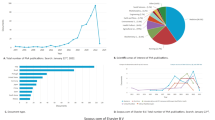Abstract
The cardiogenic impedance signal from band electrodes placed in the traditional position around the neck and lower thorax was studied by mapping the location of the signal on the sternum using 10 cm strip electrodes in eight male subjects. The band current electrodes on the neck and waist were replaced with 10cm strip electrodes on the forehead and 10 cm below the xiphisternal joint, respectively, with only small changes in the dZ/dt peak amplitude and Zo. Similarly, using a strip voltage pickup electrode at the level of the xiphisternal joint resulted in very small changes in the waveform. The amplitude of dZ/dt measured between the xiphisternal joint and points along the sternum remains small until approximately 10cm below the suprasternal notch, after which it increased linearly to the top of the neck. An average of 17 per cent and 24 per cent of the dZ/dt signal and 24 per cent and 22 per cent of the Zo signal for supine and standing, respectively, occurs above the suprasternal notch. Replacing the current electrodes with strip electrodes on the forehead and waist caused only small changes in the signal. The position of the neck strip electrode is more critical.
Similar content being viewed by others
References
Denniston, J. C., Maker, J. T., Reeves, J. T., Cruz, J. C., Cymerman, A. andGrover, R. F. (1976) Measurement of cardiac output by impedance at rest and during exercise.J. Appl. Physiol.,40, 91–95.
Donovan, K., Dobb, G., Woods, W. andHocking, B. (1986) Comparison of transthoracic electrical impedance and thermodilution methods for measuring cardiac output.Crit. Care Med.,14, 1038–1044.
Gabriel, S., Atterhog, J., Oro, L. andEkelund, L. (1976) Measurement of cardiac output by impedance cardiography in patients with myocardial infarction.Scand. J. Clin. Lab. Invest.,36, 29–34.
Hubbard, W., Fish, D. andMcBrien, D. (1986) The use of impedance cardiography in heart failure.Int. J. Cardiol.,12, 71–79.
Keim, H., Wallace, J., Thurston, H., Case, D., Drayer, J. andLaragh, J. (1976) Impedance cardiography for determination of stroke index.J. Appl. Physiol.,41, 797–799.
Kubicek, W. G., Karnegis, J. N., Patterson, R. P., Witsoe, D. A. andMattson, R. H. (1966) Development and evaluation of an impedance cardiac output system.Aerospace Med.,37, 1208–1212.
Kubicek, W., Kottke, F., Ramos, M., Patterson, R., Witsoe, D., Labree, J., Remole, W., Layman, T., Schoening, H. andGaramella, J. (1974) The Minnesota impedance cardiograph theory and applications.Biomed. Eng.,9, 410–416.
Lababidi, Z., Ehmke, D., Durnin, R., Leaverton, P. andLauer, R. (1970) The first derivative thoracic impedance cardiogram.Circ.,41, 651–658.
Mohapatra, S. (1981)Non-invasive cardiovascular monitoring by electrical impedance technique. Pitman Medical, London.
Patterson, R. P., Kubicek, W. G., Kinnen, E., Witsoe, D. A. andNoren, G. (1964) Development of an electrical impedance plethysmography system to monitor cardiac output. Proc. 1st Ann. Rocky Mountain Bioeng. Symp., USAF/IEEE, Colorado Springs, USA, 4th–5th May, 56–71.
Patterson, R. P. (1965) Cardiac output determinations using impedance plethysmography. MS thesis, University of Minnesota, USA.
Penney, B. C., Patwardhan, N. A. andWheeler, H. B. (1985) Simplified electrode array for impedance cardiography.Med. & Biol. Eng. & Comput.,23, 1–7.
Qu, M., Zhang, Y., Webster, J. G. andTompkins, W. J. (1986) Motion artifacts from spot and band electrodes during impedance cardiography.IEEE Trans.,BME-33, 1029–1039.
Ramos, M. (1977) An abnormal early diastolic impedance waveform: a predictor of poor prognosis in the cardiac patient?Am. Heart J.,94, 274–281.
Sramek, B. B. (1981) Non-invasive technique for the measurement of cardiac output by means of electrical impedance. Proc. Vth Int. Conf. Electrical Impedance, Business Center for Academic Societies Japan, Tokyo, 39–42.
Teo, K., Hetherington, M., Haennel, R., Greenwood, P., Rossall, R. andKappagoda, T. (1985) Cardiac output measured by impedance cardiography during maximal exercise tests.Cardiovasc. Res.,19, 737–743.
Zhang, Y., Qu, M., Webster, J. G., Tompkins, W. J., Ward, B. A. andBassett, D. R. (1986) Cardiac output monitoring by impedance cardiography during treadmill exercise.IEEE Trans.,BME-33, 1037–1042.
Author information
Authors and Affiliations
Rights and permissions
About this article
Cite this article
Patterson, R.P., Wang, L., Raza, B. et al. Mapping the cardiogenic impedance signal on the thoracic surface. Med. Biol. Eng. Comput. 28, 212–216 (1990). https://doi.org/10.1007/BF02442669
Received:
Accepted:
Issue Date:
DOI: https://doi.org/10.1007/BF02442669




